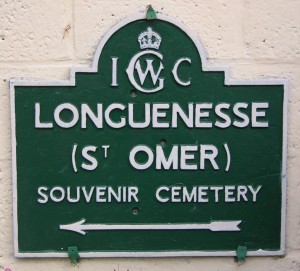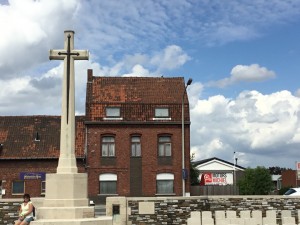Their Name Liveth for Evermore

King George V during the King’s Pilgrimage, May 1922. Fabian Ware of the Imperial War Graves Commission holding papers. Note the wooden crosses
(The King’s Pilgrimage)
The Imperial War Graves Commission
During the Great War the work of Fabian Ware and his associates in the registration of war graves did not go unnoticed. Ware and others also became concerned for what would become of their work post-war. In January 1916 the National Committee for the Care of Soldier’s Graves was formed. This organization, with Edward, Prince of Wales as President, was initially to take over the work of the Directorate of War Graves Registration and Enquiries after the Great War.
However, by early 1916 several committee members felt that a formal organization would be more appropriate to take over the work. In 1917 with the help of Prince Edward, Fabian Ware forwarded a memorandum to the Imperial War Conference suggesting the creation of such an organization. Ware’s memorandum was approved and on 21 May 1917 the Imperial War Graves Commission (IWGC) was established. With the end of the war in November 1918, the work of the IWGC grew in magnitude.

Imperial War Graves Commission sign Longuenesse (St. Omer) Souvenir Cemetery, France.
(P. Ferguson image, September 2005)
Three experimental cemeteries were constructed by the commission at Le Treport, Forceville and Louvencourt respecting the principles introduced by the Directorate of the British Museum, Frederic Kenyon. Of special interest was that the remains of the fallen should not be repatriated and that memorials should be uniform in nature in order to avoid class distinctions.

Sir Edward Lutyen’s Stone of Remembrance at Tyne Cot Cemetery, Belgium.
(P. Ferguson image, September 2010)
Three architects were appointed Sir Herbert Baker, Sir Reginald Blomfield and Sir Edward Lutyens with Rudyard Kipling as literary adviser. Work commenced in earnest and in association with the influential horticulturalist Gertrude Jekyll. The three experimental cemeteries were walled, with uniform headstones set within pristine gardens. Of the three, Forceville became the template cemetery for the Imperial War Graves Commission.

The Cross of Sacrifice designed by Sir Reginald Blomfield at the Menin Road South Military Cemetery, Ieper, Belgium.
(P. Ferguson image, August 2018)
Some revisions were made to the overall concept and decisions were made that the Stone of Remembrance was only to be placed in cemeteries with more than 400 graves, cemetery walls were limited to 1 metre in height and shelters were only built in cemeteries with more than 200 graves. In addition to the Stone of Remembrance designed by Lutyens; the Cross of Sacrifice by Blomfield, ranging in height from 18’ to 24’, was only included in cemeteries with 40 or more graves.
Rudyard Kipling lost his son to the Great War, Lieutenant John Kipling, Irish Guards, 27 September 1915, age 18. John’s loss profoundly affected his parents who searched for him in military hospitals and spoke with his comrades in efforts to learn what had happened. The loss of John inspired Rudyard Kipling’s literary work with the IWGC . Kipling chose the phrase for the inscription for Lutyen’s Stone of Remembrance, Their Name Liveth For Evermore (Ecclesiasticus) as well as the inscription on the markers of the unknown fallen, Known Unto God.
Did you Know?
In 1960 the name of the Imperial War Graves Commission was changed to the Commonwealth War Graves Commission (CWGC).
Today the CWGC is responsible for the care of more than 23,000 separate burial sites of 1.7 million deceased Commonwealth personnel. These burials are in 153 countries.
The Commission is also responsible for more than 200 memorials worldwide.
A website developed by the CWGC allows visitors to search for the fallen and where they are commemorated. See Find War Dead.

Comments